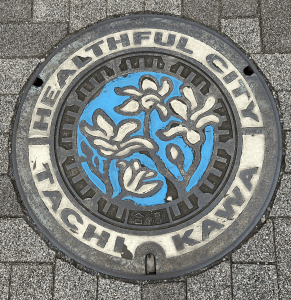
As a resident of Tachikawa City since January 2010, I’ve always been fascinated by the unique manholes that dot the streets of my neighborhood. Living just a short distance from my schoolhouse & cram school, Olives English School, I’ve made it a habit to curiously observe the unique designs and markings on these unassuming access points to the city’s underground utility infrastructure.
Tachikawa City is known for its rich history and vibrant urban landscape, and this character is reflected even in the most mundane of street fixtures – its manhole covers. While many people may overlook these utilitarian elements, I’ve found that a closer inspection reveals a wealth of intriguing details.


One unique manhole cover that caught my eye is located just a block away from my school. Adorned with the kanji character “水” (mizu), meaning “water”, this cover clearly indicates that it provides access to the city’s water supply pipes. However, what makes this particular manhole unique is the intricate floral pattern that surrounds the central character. This decorative touch adds a touch of artistry to an otherwise functional component, hinting at the care and attention the city pays to its infrastructure.
Further down the street, I stumbled upon a manhole cover with the kanji character “電” (den), signifying its connection to the local electrical grid. What sets this one apart is the bold, rectangular design that gives it an almost futuristic aesthetic. The sharp lines and geometric patterns create a striking visual contrast against the more traditional-looking covers in the area.

As I continued my exploration, I noticed that not all the unique manholes in Tachikawa follow a standardized design. Near the Tamagawajosui Station, I encountered a cover that featured the kanji character “排” (hai), denoting its function as a drainage access point. However, instead of the usual plain metal surface, this one was adorned with a delicate water-drop motif, almost resembling a decorative ceramic tile.
These are just a few examples of the diverse and captivating manhole covers I’ve discovered in my own neighborhood of Tachikawa City. Each one tells a story about the city’s infrastructure, history, and the attention to detail that goes into maintaining its public spaces.

For those who take the time to look down and observe these often-overlooked elements of the urban landscape, Tachikawa’s unique manholes offer a window into the city’s character and the pride its residents take in their community. So the next time you find yourself in Tachikawa, northwest part of Metropolitan Tokyo, be sure to keep an eye out for these hidden gems underfoot.
What initially seemed like an ordinary part of the urban landscape quickly transformed into a source of wonder and exploration for me. I started documenting the different manhole covers I encountered, photographing the various kanji characters, patterns, and design elements that made each one distinct. It became a personal project to uncover the stories and meanings behind these hidden gems of Tachikawa’s infrastructure.


Here are some other common kanji characters that can be found on the unique manholes in Tokyo, besides the character for “water” (水):
電 (den) – This kanji represents “electricity” and is used for manholes related to electrical cables and wiring.
ガ (ga) – This kanji represents “gas” and is used for manholes related to gas pipes and infrastructure.
通 (tsū) – This kanji represents “communication” or “passage” and is used for manholes related to telecommunication cables, internet, and other communication networks.
排 (hai) – This kanji represents “drainage” or “discharge” and is used for manholes related to sewage and wastewater systems.
消 (shō) – This kanji represents “fire” and can be found on manholes related to fire hydrants or firefighting equipment.
信 (shin) – This kanji represents “information” or “communication” and may be used for manholes related to data cables or telecommunication infrastructure.
管 (kan) – This kanji represents “pipe” or “tube” and can be found on manholes for various utility pipes and conduits.
These are some of the more common kanji characters you might encounter on manhole covers in the Tokyo metropolitan area. The specific markings can vary depending on the local municipality and the type of utility infrastructure underneath.
Related article: Japan Manhole Covers: Like a Treasure-Hunting for Tourists Now!
Inspired by their beauty and significance, I wanted to share this hidden gem with the world. Last year in December, I selected some manhole designs around Japan and sent messages to the respective authorities.
In early January of this year, I received permission from city and prefectural offices to begin designing and marketing replica manhole cover products as a way to boost tourism and express my gratitude for being welcomed into the Japanese way of life.
By offering these replica manhole covers, my hope is to not only celebrate Japan’s rich cultural heritage, but also provide travelers with a unique and memorable souvenir that captures the essence of this fascinating country. It’s my small way of giving back after so many years of enjoying all that Japan has to offer.
Japan Manhole Souvenirs & Gifts (Love Japan Omiyage):
(1) OLIVES, Inc. Shop: www.oliveskk.com/shop
(2) Filipina Edupreneur Shop: www.filipinaedupreneur.com/shop
(3) Amazon Store in 15 Marketplaces/Countries (Brand Registry): OLIVES, Inc.






Thank you for your sharing. I am worried that I lack creative ideas. It is your article that makes me full of hope. Thank you. But, I have a question, can you help me?
Your point of view caught my eye and was very interesting. Thanks. I have a question for you.